Influence of Sublacustrine Fan Depositional Model on Distribution and Morphology of Reservoirs: A Case Study in Eastern Slope of Liaoxi Uplift, Bohai Bay Basin, East China
Abstract
:1. Introduction
2. Regional Geological Setting

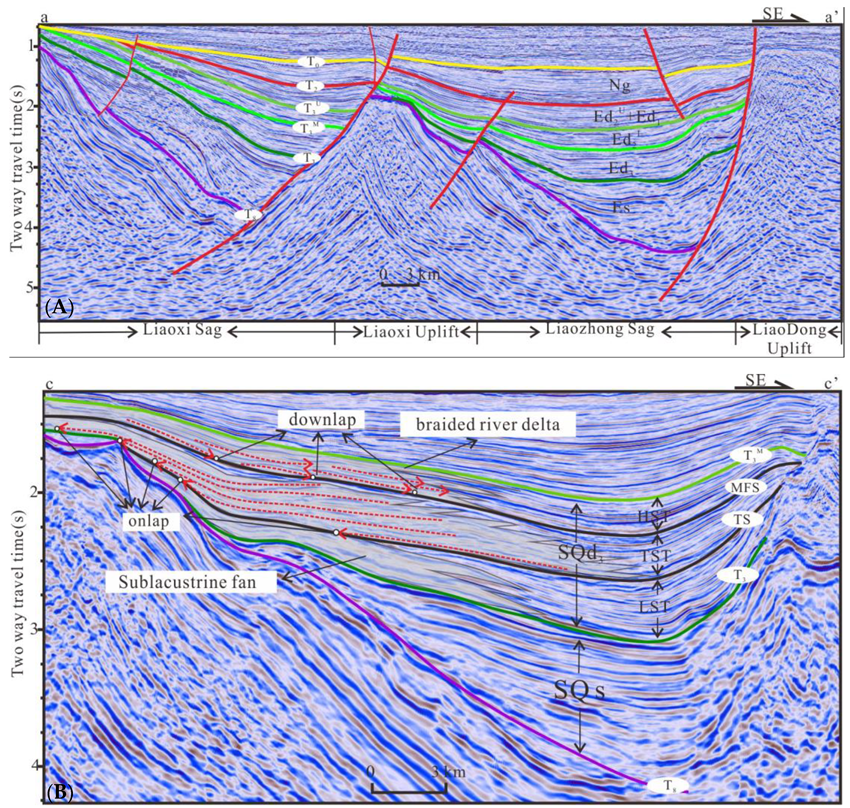
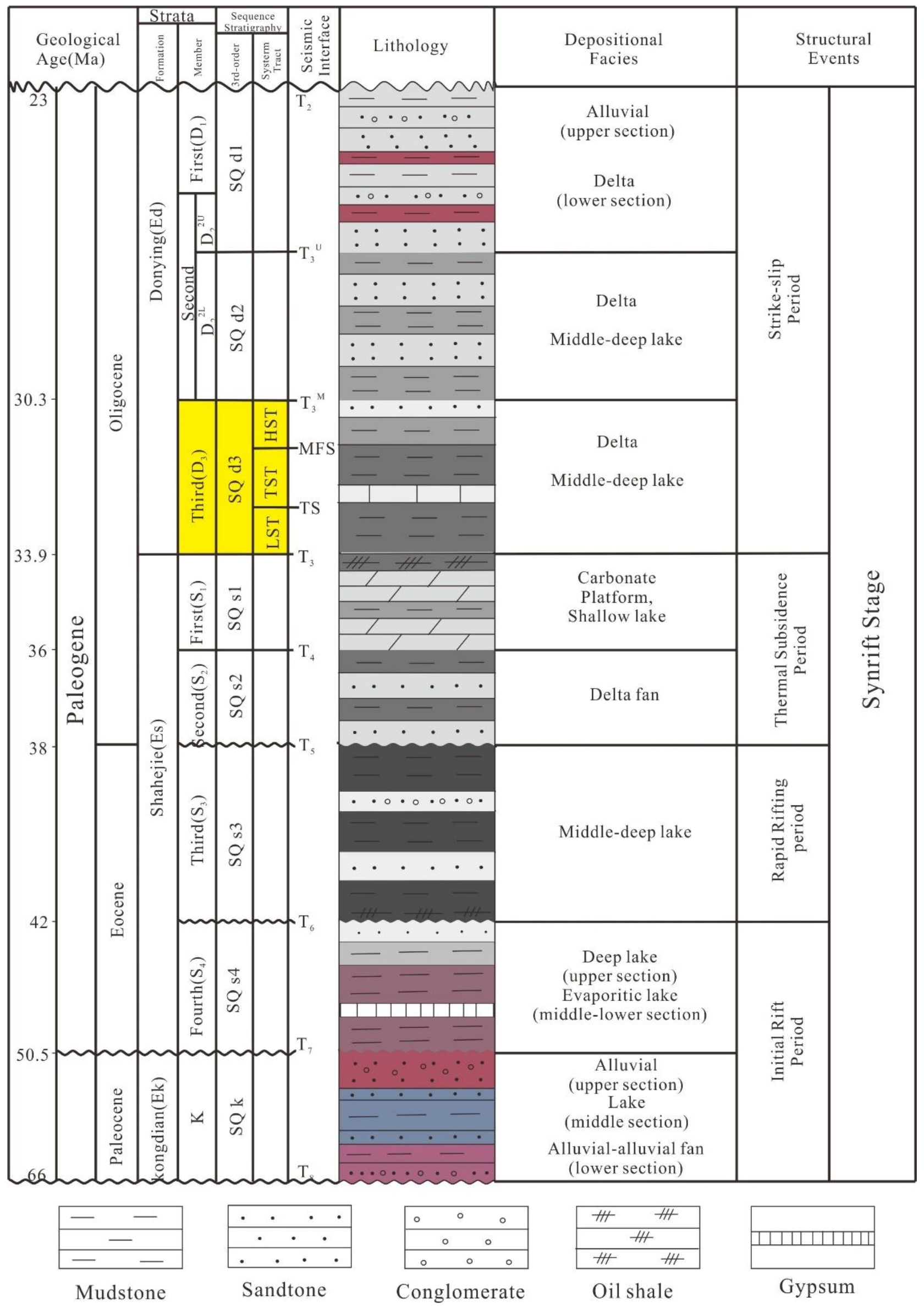
3. Data and Methods
3.1. Data
3.2. Methods
3.2.1. Well-Seismic Data Combination
3.2.2. Sequence Stratigraphic
3.2.3. Method of the Paleomorphology Reconstruction
3.2.4. Method of Relative Lake Level Change Analysis
4. Results
4.1. Sedimentary Characteristics
4.2. Logging Curve Characteristics
4.3. Relative Lake Level Change
4.4. Seismic Facies Characteristics
4.5. Paleomorphic Features
5. Discussion
5.1. Types and Distribution Characteristics of Sublacustrine Fan
5.1.1. Channelized Fan
5.1.2. Non-Channelized Fan
Tongue-Shaped Fan
Lobe-Shaped Fan
5.2. Controlling Factors of Sublacustrine Fans Morphology
5.2.1. Slope Gradient
5.2.2. Sand Richness (Braided River Delta Front)
5.3. Controlling Factors for the Development of Sublacustrine Fans in TST
5.3.1. Provenance
5.3.2. Relative Lake Level Change
5.3.3. Paleomorphology
5.4. Reservoir Distribution and Implications
6. Conclusions
Author Contributions
Funding
Data Availability Statement
Conflicts of Interest
References
- Walker, R.G. Deep-Water sandstone facies and ancient submarine fans: Models for exploration for stratigraphic traps. Am. Assoc. Pet. Geol. 1978, 62, 932–966. [Google Scholar]
- Normark, W.R. Growth patterns of deep sea fans. Am. Assoc. Pet. Geol. Bull. 1978, 54, 2170–2195. [Google Scholar]
- Reading, H.G.; Richards, M. Turbidite Systems in Deep-Water Basin Margins Classified by Grain Size and Feeder System1. Aapg Bull. 1994, 78, 792–822. [Google Scholar]
- Richards, M.; Bowman, M. Submarine fans and related depositional systems II: Variability in reservoir architecture and wireline log character. Mar. Petrol. Geol. 1998, 15, 821–839. [Google Scholar] [CrossRef]
- Richards, M.; Bowman, M.; Reading, H. Submarine-fan systems I: Characterization and stratigraphic prediction. Mar. Petrol. Geol. 1998, 15, 689–717. [Google Scholar] [CrossRef]
- Shanmugam, G. High-denstiy turbidity currents: Are they sandy debris flows? J. Sediment. Res. 1996, 66, 2–10. [Google Scholar] [CrossRef]
- Shanmugam, G. Slope turbidite packets in a fore-arc basin fill sequence of the Plio-Pleistocene Kakegawa Group: Their formation and sea-level changes—Discussion. Sediment. Geol. 1997, 112, 297–300. [Google Scholar] [CrossRef]
- Shanmugam, G. The Bouma Sequence and the turbidite mind set. Earth Sci. Rev. 1997, 42, 201–229. [Google Scholar] [CrossRef]
- Feng, Y.; Li, S.; Lu, Y. Sequence stratigraphy and architectural variability in Late Eocene lacustrine strata of the Dongying Depression, Bohai Bay Basin, Eastern China. Sediment. Geol. 2013, 295, 1–26. [Google Scholar] [CrossRef]
- Jia, J.; Liu, Z.; Miao, C.; Fang, S.; Zhou, R.; Meng, Q.; Chen, Y.; Yan, L.; Yang, D. Depositional model and evolution for a deep-water sublacustrine fan system from the syn-rift Lower Cretaceous Nantun Formation of the Tanan Depression (Tamtsag Basin, Mongolia). Mar. Petrol. Geol. 2014, 57, 264–282. [Google Scholar] [CrossRef]
- Liu, X.; Chen, H.; Xiao, X.; Zhang, T. Mixing Characteristics of Oil Inclusions with Different Thermal Maturities in the Wenliu Uplift, Dongpu Depression, Bohai Bay Basin, North China. J. Earth Sci. China 2020, 6, 1251–1258. [Google Scholar] [CrossRef]
- Fongngern, R.; Olariu, C.; Steel, R.; Mohrig, D.; Krézsek, C.; Hess, T. Subsurface and outcrop characteristics of fluvial-dominated deep-lacustrine clinoforms. Sedimentology 2018, 65, 1447–1481. [Google Scholar] [CrossRef]
- Maejima, W.; Das, R.; Pandya, K.L.; Hayashi, M.; Maejima, W.; Chaudhuri, A.K. Deglacial control on sedimentation and basin evolution of Permo-Carboniferous Talchir Formation, Talchir Gondwana Basin, Orissa, India. Gondwana Res. 2004, 7, 339–352. [Google Scholar] [CrossRef]
- Yao, Y.; Guo, Q.; Wang, H. Source-to-Sink Comparative Study between Gas Reservoirs of the Ledong Submarine Channel and the Dongfang Submarine Fan in the Yinggehai Basin, South China Sea. Energies 2022, 15, 4298. [Google Scholar] [CrossRef]
- Xue, Y.A.; Zhao, M.; Liu, X. Reservoir Characteristics and Controlling Factors of the Metamorphic Buried Hill of Bozhong Sag, Bohai Bay Basin. J. Earth Sci. China 2021, 32, 919–926. [Google Scholar] [CrossRef]
- Guo, J.; Jiang, Z.; Xie, X.; Liang, C.; Wang, W.; Busbey, A.B.; Jia, C.; Meng, J. Deep-lacustrine sediment gravity flow channel-lobe complexes on a stepped slope: An example from the Chengbei Low Uplift, Bohai Bay Basin, East China. Mar. Petrol. Geol. 2021, 124, 104839. [Google Scholar] [CrossRef]
- Lin, C.; Kenneth, E.; Li, S.; Wan, Y.; Ren, J.; Zhang, Y. Sequence architecture, depositional systerm, and controls on development of lacustrine basin fills in part of the Erlian basin, northeast China. Aapg Bull. 2001, 85, 2017–2043. [Google Scholar]
- Liu, E.; Wang, H.; Li, Y.; Zhou, W.; Leonard, N.D.; Lin, Z.; Ma, Q. Sedimentary characteristics and tectonic setting of sublacustrine fans in a half-graben rift depression, Beibuwan Basin, South China Sea. Mar. Petrol. Geol. 2014, 52, 9–21. [Google Scholar] [CrossRef]
- Liu, E.; Wang, H.; Pan, S.; Qin, C.; Jiang, P.; Chen, S.; Yan, D.; Lü, X.; Jing, Z. Architecture and depositional processes of sublacustrine fan systems in structurally active settings: An example from Weixinan Depression, northern South China Sea. Mar. Petrol. Geol. 2021, 134, 105380. [Google Scholar] [CrossRef]
- Xia, S.; Liu, J.; Liu, Z.; Ye, D.; Chang, Y.; Gao, N.; Li, H.; Liang, X. The geophysical identification, characteristics, and petroliferous significance of sublacustrine fan deposits in the second member of Dongying Formation in Liaozhong Depression, Bohai Bay Basin. Geol. J. 2018, 53, 692–706. [Google Scholar] [CrossRef]
- Cao, Y.; Jin, J.; Liu, H.; Yang, T.; Liu, K.; Wang, Y.; Wang, J.; Liang, C. Deep-water gravity flow deposits in a lacustrine rift basin and their oil and gas geological significance in eastern China. Petrol. Explor Dev. 2021, 48, 286–298. [Google Scholar] [CrossRef]
- Liu, E.; Wang, H.; Feng, Y.; Pan, S.; Jing, Z.; Ma, Q.; Gan, H.; Zhao, J. Sedimentary architecture and provenance analysis of a sublacustrine fan system in a half-graben rift depression of the South China Sea. Sediment. Geol. 2020, 409, 105781. [Google Scholar] [CrossRef]
- Lei, Z.; Jiang, Z.; Zhang, J. Sedimentary characteristics, genetic types and control factors of deep-water sandstones in the western Linjin Sag, China. Mar. Petrol. Geol. 2019, 113, 104130. [Google Scholar] [CrossRef]
- Liu, J.; Xian, B.; Wang, J.; Ji, Y.; Lu, Z.; Liu, S. Sedimentary architecture of a sub-lacustrine debris fan: Eocene Dongying Depression, Bohai Bay Basin, east China. Sediment. Geol. 2017, 362, 66–82. [Google Scholar] [CrossRef]
- Praet, N.; Moernaut, J.; Van Daele, M.; Boes, E.; Haeussler, P.J.; Strupler, M.; Schmidt, S.; Loso, M.G.; Batist, M.D. Paleoseismic potential of sublacustrine landslide records in a high-seismicity setting (south-central Alaska). Mar. Geol. 2017, 384, 103–119. [Google Scholar] [CrossRef]
- Sun, M.; Wang, H.; Liao, J.; Gan, H.; Xiao, J.; Ren, J.; Zhao, S.E. Sedimentary characteristics and model of gravity flow depositional system for the first member of upper Miocene Huangliu Formation in Dongfang area, Yinggehai basin, northwestern South China Sea. J. Earth Sci. China 2014, 25, 506–518. [Google Scholar] [CrossRef]
- Van der Merwe, W.C.; Flint, S.S.; Hodgson, D.M. Sequence stratigraphy of an argillaceous, deepwater basin-plain succession: Vischkuil Formation (Permian), Karoo Basin, South Africa. Mar. Petrol. Geol. 2010, 27, 321–333. [Google Scholar] [CrossRef]
- Gao, W.; Zhang, Z.; Guo, J.; Tan, H.; Jiang, B.; Li, Y. Seismic response mechanism analysis and reservoir description for sublacustrine fan of Dongying Formation in Liaodong Bay. China Offshore Oil Gas 2017, 29, 48–55. [Google Scholar]
- Wang, Q.; Du, X.; Jia, D.; Xu, C. Numerical Simulation Study of Sublucstrine fan Sedimentation in Lower second member of Liaozhong Sag. Pet. Geol. Eng. 2015, 29, 15–18+153–154. [Google Scholar]
- Jia, D.; Zhou, X.; Li, J.; Lai, W.; Zhu, C. Depositional model and controlling factors of sedimentary gravity flows in the central-northern Liaozhong sag, China. J. Chengdu Univ. Technol. 2010, 37, 69–74. [Google Scholar]
- Wu, K.; Wu, J.; Zhang, Z.; Jin, X.; Liu, Y.; Yu, Q. Sedimentary model and seismic respones characteristic of the sublucatrine fan in Northern Liaozhong Depression. J. Northeast. Pet. Univ. 2012, 36, 6+33–37+50. [Google Scholar]
- Zhang, H.; Lv, D.; Guan, D.; Wang, Q.; Liu, J. Study on hydrocarbon accumulation difference of sub-lacustrine fan in Dongying Formation in Liaozhong Sag, Liaodong Bay. China Pet. Explor. 2021, 26, 95–106. [Google Scholar]
- Qi, J.; Chen, F. Structural Style of the Liaodongwan-Xialiaohe Rift Basin. Oil Gas Geol. 1992, 13, 272–282. [Google Scholar]
- Zhu, X.; Dong, Y.; Yang, J.; Zhang, Q.; Li, D.; Xu, C.; Yu, S. The Paleogene Sequence Stratigraphic Framework and Distribution of Sedimentary Systems in the Liaodong Bay Area. Earth Sci. 2008, 51, 1–10. [Google Scholar]
- Zhou, X.; Wang, Q.; Feng, C.; Ye, T.; Liu, X.; Hao, Y.; Zhou, L. Formation Conditions and Geological Significance of Large Archean Buried Hill Reservoirs in Bohai Sea. Earth Sci. J. China Univ. Geosci. 2022, 47, 1534–1548. [Google Scholar]
- Zhu, W.; Mi, L.; Gong, Z. Oil and Gas Accumulation and Exploration in the Bohai Sea; Science Press: Beijing, China, 2009; p. 77. [Google Scholar]
- Zhou, X.; Yu, Y.; Tang, L.; Lv, D.; Wang, Y. Cenozoic basin structure and division of tectonic units in the Bohai Sea. China Offshore Oil Gas 2010, 22, 285–289. [Google Scholar]
- Xia, Q.; Zhou, X.; Li, J. The Sequence Sedimentary Evolution and Reservoir Distribution of Paleogene of Bohai Sea; Petroleum Industry Press: Beijing, China, 2012; pp. 14–22. [Google Scholar]
- Jia, N.; Huang, L.; Liu, C.; Li, D.; Xu, C. Differential faulting in a narrow rift basin influenced by synchronous strike-slip motion: The Liaodong Bay sub-basin, offshore Bohai Bay Basin, China. Mar. Petrol. Geol. 2021, 124, 104853. [Google Scholar] [CrossRef]
- Huang, L.; Liu, C.; Wang, Y.; Xue, Y.; Zhao, J. Hydrocarbon accumulation in strike-slip fault restraining bends: New insights into the tectonic controls on the Penglai 19-3 and Penglai 25-6 oil fields, Tan-Lu fault zone, east China. Aapg Bull. 2016, 100, 1239–1263. [Google Scholar] [CrossRef]
- Catuneanu, O. Principles of Sequence Stratigraphy; Elsevier: Amsterdam, The Netherlands, 2006; p. 375. [Google Scholar]
- Catuneanu, O. Model-independent sequence stratigraphy. Earth Sci. Res. 2019, 188, 312–388. [Google Scholar] [CrossRef]
- Lowe, D.R. Sediment Gravity Flows II: Depositional models with special reference to the deposits of high-density turbidity currents. J. Sediment. Petrol. 1982, 52, 279–297. [Google Scholar]
- Fisher, A.G. The lofer cyclothems of the alpine Triassic. Kans. Geol. Surv. Bull. 1964, 169, 107–149. [Google Scholar]
- Read, J.F.; Goldhammer, R.K. Use of Fischer plots to define third-order sea-level curves in Ordovician peritidal cyclic carbonates, appalachians. Geology 1988, 16, 895–899. [Google Scholar] [CrossRef]
- Sadler, P.M.; Osleger, D.A.; Montanez, I.P. On the labeling, length, and objective basis of Fischer plots. J. Sediment. Petrol. 1993, 63, 360–368. [Google Scholar]
- Crerar, E.E.; Arnott, R.W.C. Facies distribution and stratigraphic architecture of the Lower Cretaceous McMurray Formation, Lewis Property, northeastern Alberta. B Can. Petrol. Geol. 2007, 55, 99–124. [Google Scholar] [CrossRef]
- Liu, J.; Steel, R.J.; Lin, C.; Yang, H.; Yang, Y.; Peng, L.; Gong, Y.; Chu, C. Geomorphology control on the development of reservoir depositional systems, Devonian Donghetang Formation in the Tabei Uplift of the Tarim Basin, China. Mar. Petrol. Geol. 2012, 38, 177–194. [Google Scholar] [CrossRef]
- Posamentier, H.W.; Allen, G.P. Variability of the sequence stratigraphic model: Effects of local basin factors. Sediment. Geol. 1993, 86, 91–109. [Google Scholar] [CrossRef]
- Shanmugam, G. New perspectives on deep-water sandstones: Implications. Pet. Explor. Dev. 2013, 40, 294–301. [Google Scholar] [CrossRef]
- Migeon, S.; Ducassou, E.; Le Gonidec, Y.; Rouillard, P.; Mascle, J.; Revel-Rolland, M. Lobe construction and sand/mud segregation by turbidity currents and debris flows on the western Nile deep-sea fan (Eastern Mediterranean). Sediment. Geol. 2010, 229, 124–143. [Google Scholar] [CrossRef]
- Shanmugam, G. New Perspective on Deep-Water Sandstones: Origin, Recognition, Initiation, and Reservoir Quality. In Handbook of Petroleum Exploration and Production; Elsevier: Amsterdam, The Netherlands, 2006; Volume 9, p. 524. [Google Scholar]
- Zou, C.; Wang, L.; Li, Y.; Tao, S.; Hou, L. Deep-lacustrine transformation of sandy debrites into turbidites, Upper Triassic, Central China. Sediment. Geol. 2012, 265–266, 143–155. [Google Scholar] [CrossRef]
- Song, Y.; Yin, T.; Zhang, C.; Liu, Z. Numerical simulation of a branch-channel delta. Pet. Geol. Oilfield Dev. Daqing 2021, 40, 42–50. [Google Scholar]
- Shanmugam, G.; Spalding, T.D.; Rofheart, D.H. Process Sedimentology and Reservior Quality of Deep-Marine Bottom-Current Reworked Sands (Sandy Contourites): An example from the Gulf of Mexico. AMerican Assoc. Pet. Geol. Bull. 1993, 77, 1241–1259. [Google Scholar]
- Xu, C.; Xu, X.; Qiu, D.; Lai, W.; Zhou, X. Structural and sequence stratigraphic frameworks and palaeogeography of the Paleogene in central-southern Liaoxi Sag, Liaodongwan Bay area. J. Palaeogeogr. 2005, 7, 449–459. [Google Scholar]
- Brothers, D.S.; Luttrell, K.M.; Chaytor, J.D. Sea-level-induced seismicity and submarine landslide occurrence. Geology 2013, 41, 979–982. [Google Scholar] [CrossRef]
- Neves, M.C.; Roque, C.; Luttrell, K.M.; Vázquez, J.T.; Alonso, B. Impact of sea-level rise on earthquake and landslide triggering offshore the Alentejo margin (SW Iberia). Geo Mar. Lett 2016, 36, 415–424. [Google Scholar] [CrossRef]
- Trincardi, F.; Cattaneo, A.; Correggiari, A.; Mongardi, S. Submarine Slides during Relative Sea Level Rise: Two Examples from the Eastern Tyrrhenian Margin; Springer: Dordrecht, The Netherlands, 2003; pp. 469–478. [Google Scholar]
- Jiang, Z.; Liu, H. Lacustrine palaeoshoreline and its controls on sandbodies and hydrocarbon. J. Palaeogeogr. 2010, 12, 589–598. [Google Scholar]
- Wang, C.; Zhang, Y.; Lin, S.; Zheng, R.; Wei, Y.; Wang, H.; Hou, C.; Gou, X. Discovery of double slope breaks and its significance in Chang 81 sand group in Zhenyuan Area, Ordos Basin. Oil Gas Geol. 2017, 38, 457–466. [Google Scholar]
- Zhang, H.; Wang, H.; Liu, X.; Zhao, H. Determination of lacustrine palaeoshore line and its controls on the high quality reservoir: A case from the 8th member of Shihezi Formation in North Ordos Basin. Acta Sedimentol. Sin. 2015, 33, 348–356. [Google Scholar]
- Jiang, Z.; Liu, H.; Zhang, S.; Su, X.; Jiang, Z. Sedimentary characteristics of large-scale lacustrine beach-bars and their formation in the Eocene Boxing Sag of Bohai Bay Basin, East China. Sedimentology 2011, 58, 1087–1112. [Google Scholar] [CrossRef]
- Scholz, C.A.; Rosendahl, B.R. Low lake stands in lakes Malawi and tanganyika, East Africa, delineated with multifold seismic data. Science 1988, 240, 1645–1653. [Google Scholar] [CrossRef]
- Thompson, T.A.; Baedke, S.J.; Tanner, W.F. Beach-ridge development in Lake Michigan; shoreline behavior in response to quasi-periodic lake-level events. Mar. Geol. 1995, 129, 163–174. [Google Scholar] [CrossRef]
- White, J.D. Pliocene subaqueous fans and Gilbert-type deltas in maar crater lakes, Hopi Buttes, Navajo Nation (Arizona), USA. Sedimentology 1992, 39, 931–946. [Google Scholar] [CrossRef]
- Wu, W.; Lin, C.; Zhou, X.; Li, Q.; Xing, Z.; Yan, Y. Paleoclimate evolution and its influence on lake level changes of Paleogene dongying epoch in liaodong Bay, east China. J. China Univ. Pet. Ed. Nat. Sci. 2012, 36, 33–39+46. [Google Scholar]
- Feng, D.; Deng, H.; Zhou, Z.; Gao, X.; Cui, L. Paleotopographic controls on facies development in various types of braid-delta depositional systems in lacustrine basins in China. Geosci Front. 2015, 6, 579–591. [Google Scholar] [CrossRef] [Green Version]
- Lemons, D.R.; Chan, M.A. Facies Architecture and Sequence Stratigraphy of Fine-Grained Lacustrine Deltas Along the Eastern Margin of Late Pleistocene Lake Bonneville, Northern Utah and Southern Idaho. AAPG Bullein 1999, 83, 635–665. [Google Scholar]
- Yoon, S.H.; Chough, S.K.; Park, S.J. Sequence model and its application to a Miocene shelf–slope system in the tectonically active Ulleung Basin margin, East Sea (Sea of Japan). Mar. Petrol. Geol. 2003, 20, 1089–1103. [Google Scholar] [CrossRef]
- Prather, B.E. Controls on reservoir distribution, architecture and stratigraphic trapping in slope settings. Mar. Petrol. Geol. 2003, 20, 529–545. [Google Scholar] [CrossRef]
- Qian, W.; Yin, T.; Zhang, C.; Tang, H.; Hou, G. Diagenetic evolution of the Oligocene Huagang Formation in Xihu sag, the East China Sea Shelf Basin. Sci. Rep. 2020, 10, 19402. [Google Scholar] [CrossRef] [PubMed]
- Jia, B.; Chen, Z.; Xian, C. Investigations of CO2 storage capacity and flow behavior in shale formation. J. Petrol. Sci. Eng. 2022, 208, 109659. [Google Scholar] [CrossRef]
- Yiming, L.; Jiaren, Y.; Fei, Z.; Xuechun, L.; Aiping, Q.; Weilong, L.; Jun, Z. Fluid Identification and Evaluation of Tight Sandstone Reservoir in Es2 of Qibei Slope Belt in Qikou Sag. Earth Sci. J. China Univ. Geosci. 2022, 47, 1762–1776. [Google Scholar]
- Cui, J.; Yuan, X.; Wu, S.; Zhang, R.; Jin, S.; Li, Y. Rock Types and Reservoir Characteristics of Shahejie Formation Marl in Shulu Sag, Jizhong Depression, Bohai Bay Basin. J. Earth Sci. China 2021, 32, 986–997. [Google Scholar] [CrossRef]
- Peng, G.; Pang, X.; Xu, Z.; Luo, J.; Yu, S.; Li, H.; Hu, T.; Wang, C.; Liu, Y. Characteristics of Paleogene Whole Petroleum System and Orderly Distribution of Oil and Gas Reservoirs in South Lufeng Depression, Pearl River Mouth Basin. Earth Sci. J. China Univ. Geosci. 2022, 47, 2494–2508. [Google Scholar]
- Chengmin, N.; Haifeng, Y.; Dijiang, Z.; Can, Z.; Jingsong, P. Study on the Ultra-Late Hydrocarbon Accumulation and Migration Lagging Effect in Laizhouwan Sag, Bohai Sea. Earth Sci. J. China Univ. Geosci. 2022, 47, 464–478. [Google Scholar]
- Shanmugam, G. Submarine fans: A critical retrospective (1950–2015). J. Palaeogeogr. 2016, 5, 110–184. [Google Scholar] [CrossRef] [Green Version]
- Vail, P.R.; Mitchum, R.M.; Todd, R.G. Seismic Stratigraphy and Global Changes of Seal-evel. In Seismic Stratigraphy-Applications to Hydrocarbon Exploration; AAPG Memoir, Payton, C.E., Eds.; American Association of Petroleum Geologists: Tulsa, OK, USA, 1977; Volume 26, pp. 49–212. [Google Scholar]
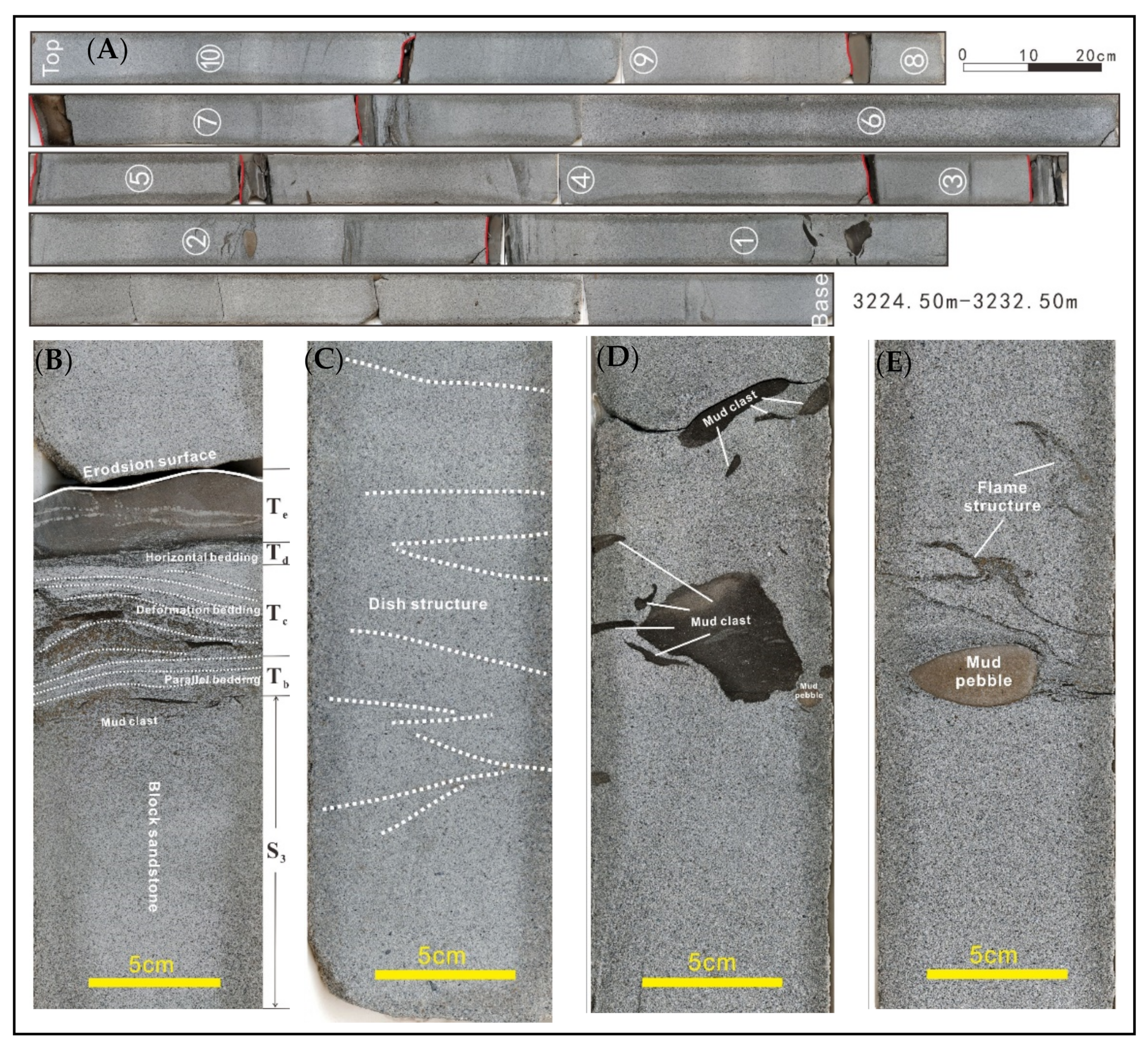

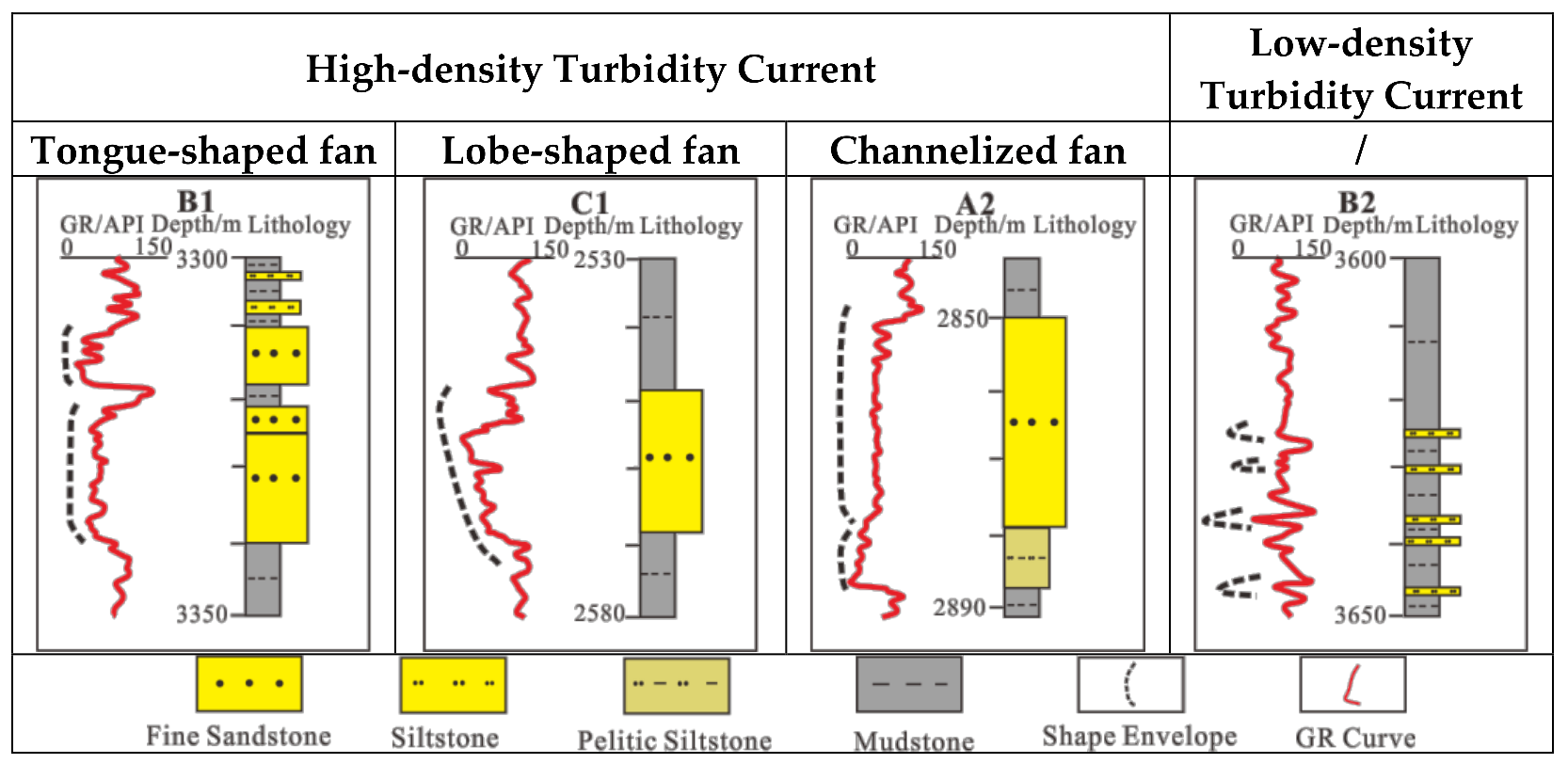


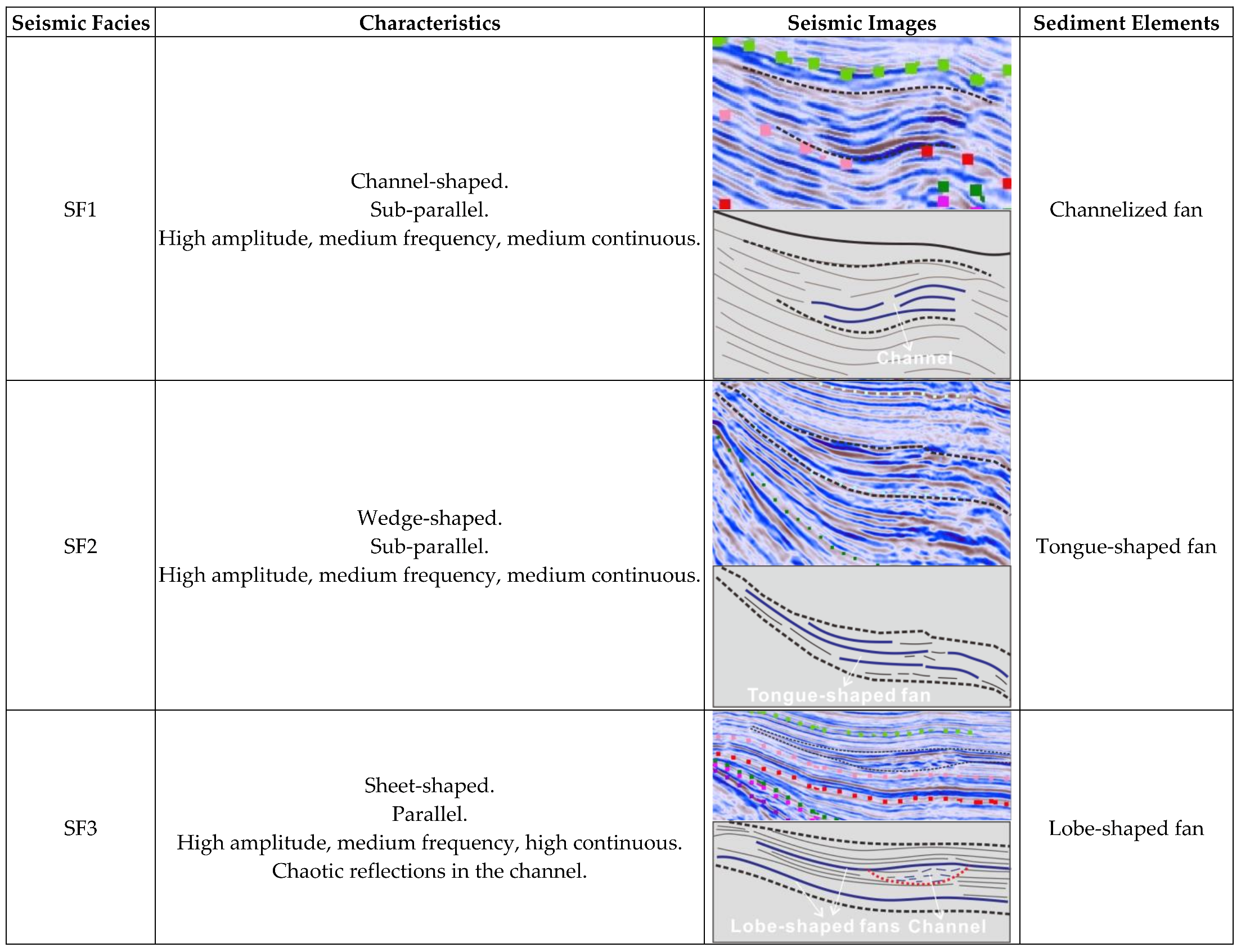


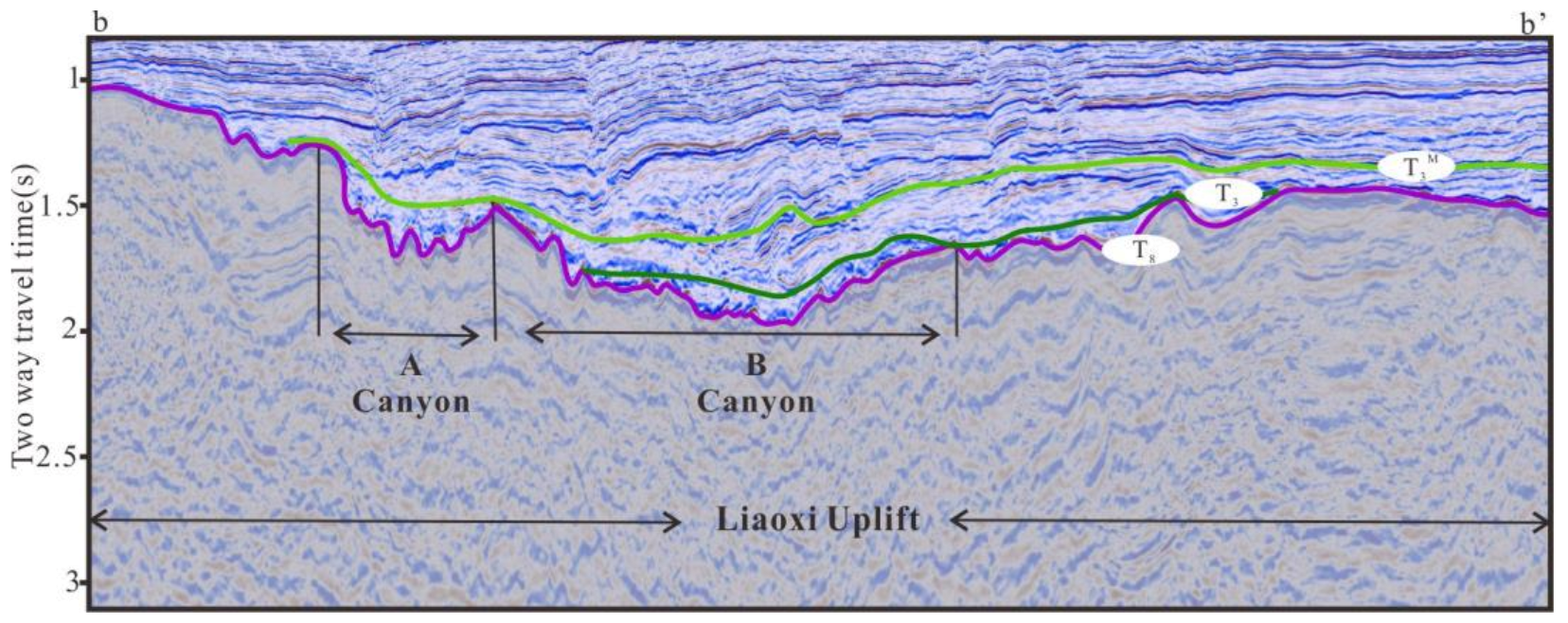
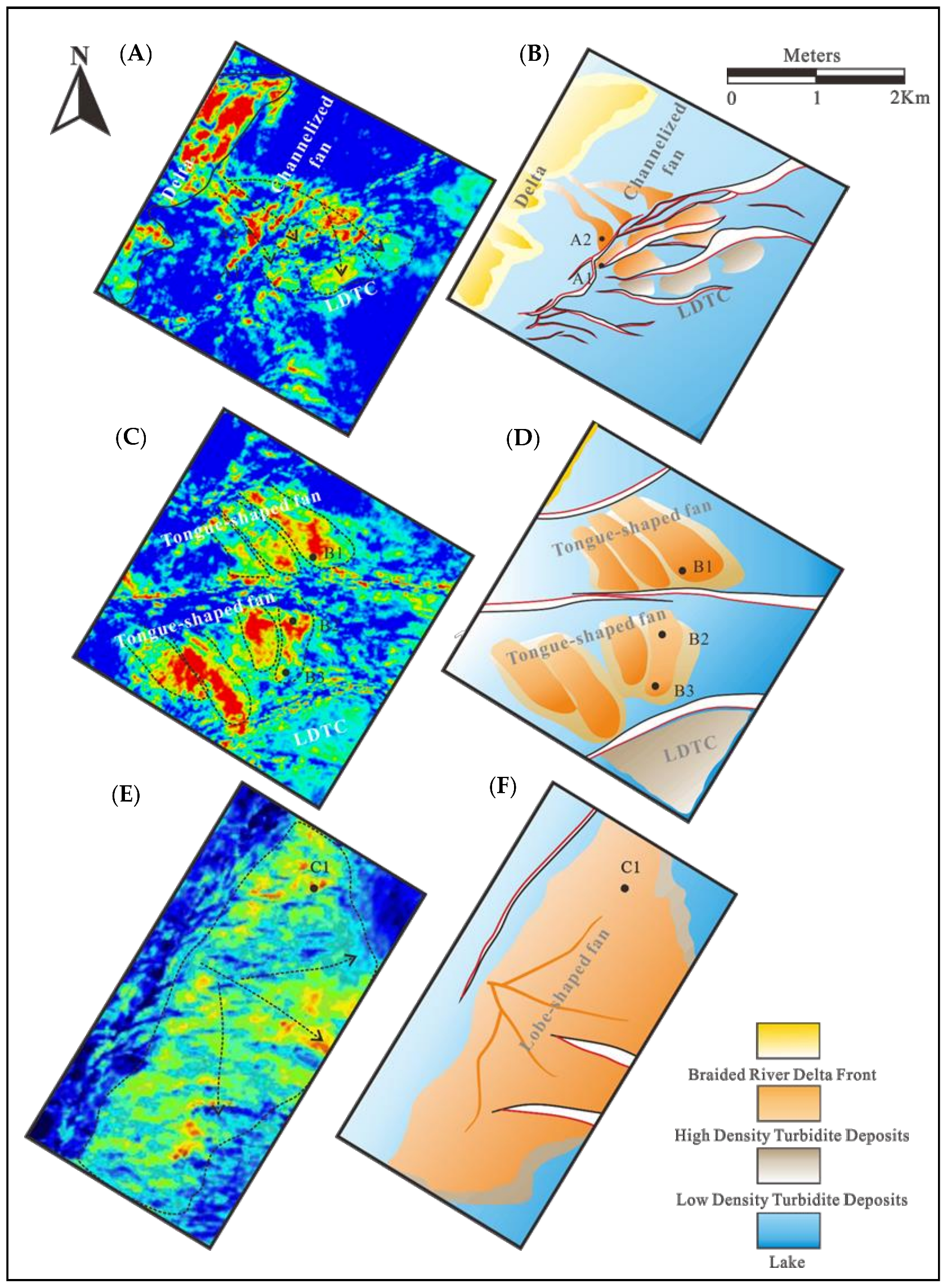
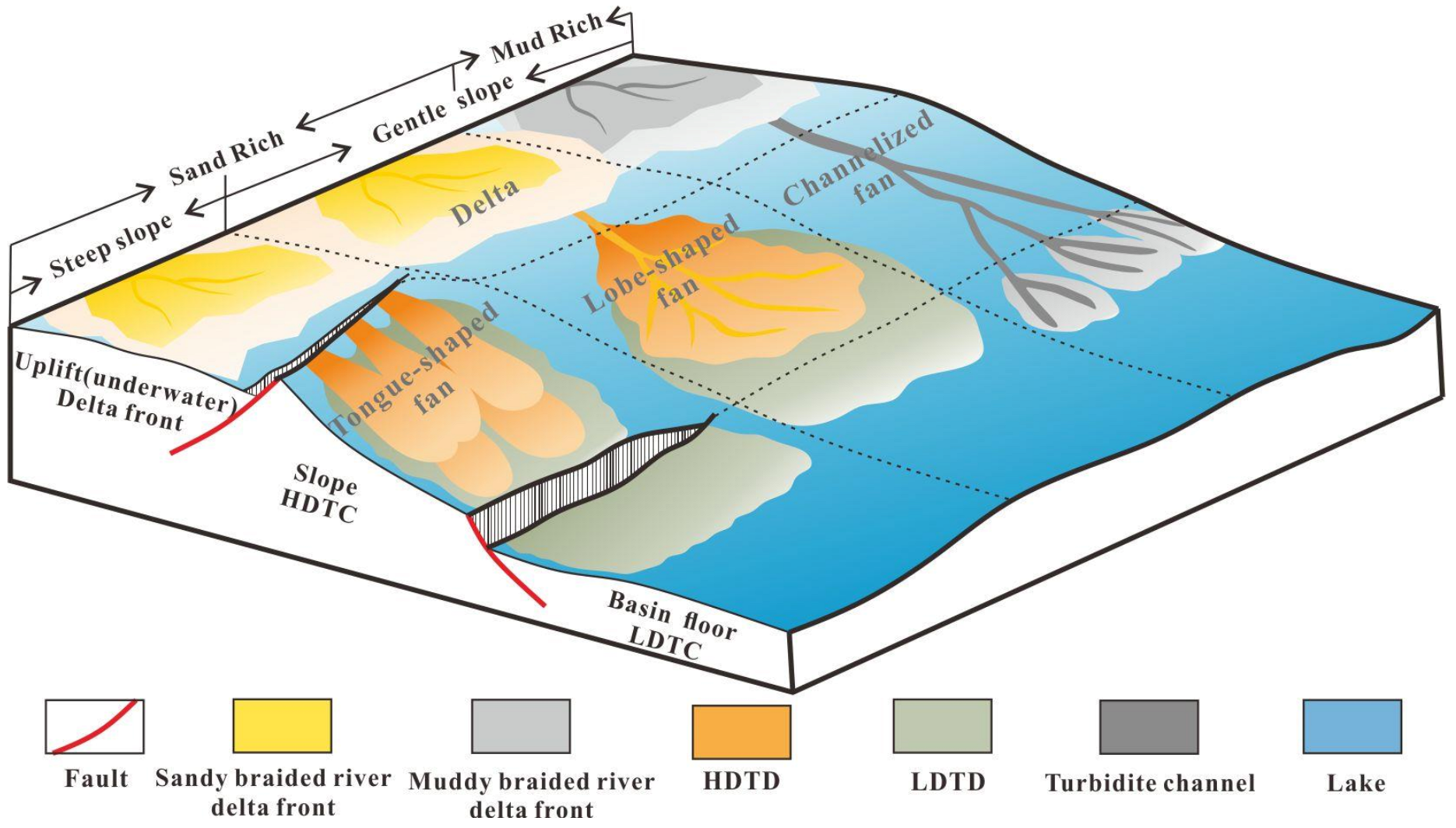

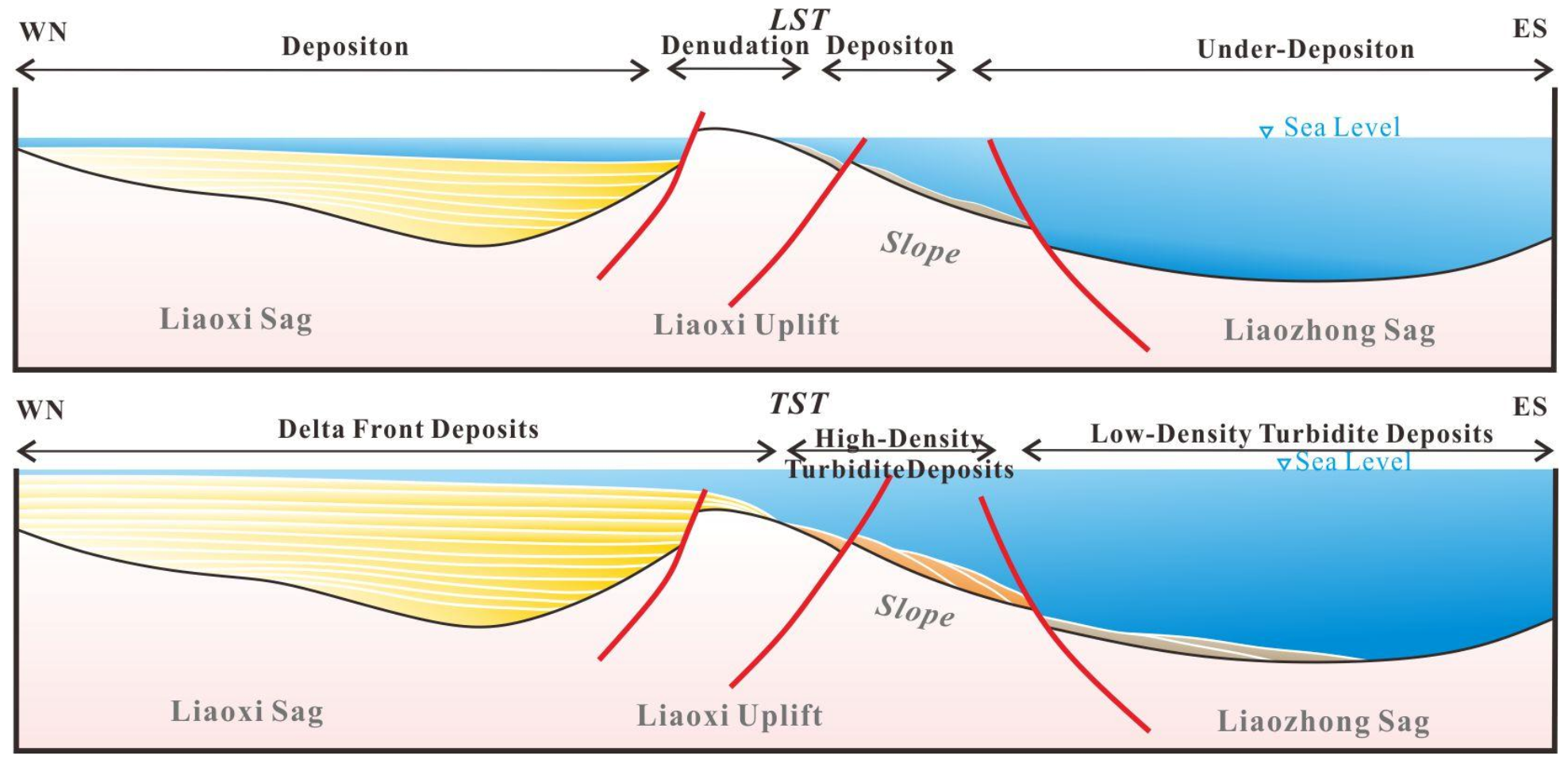
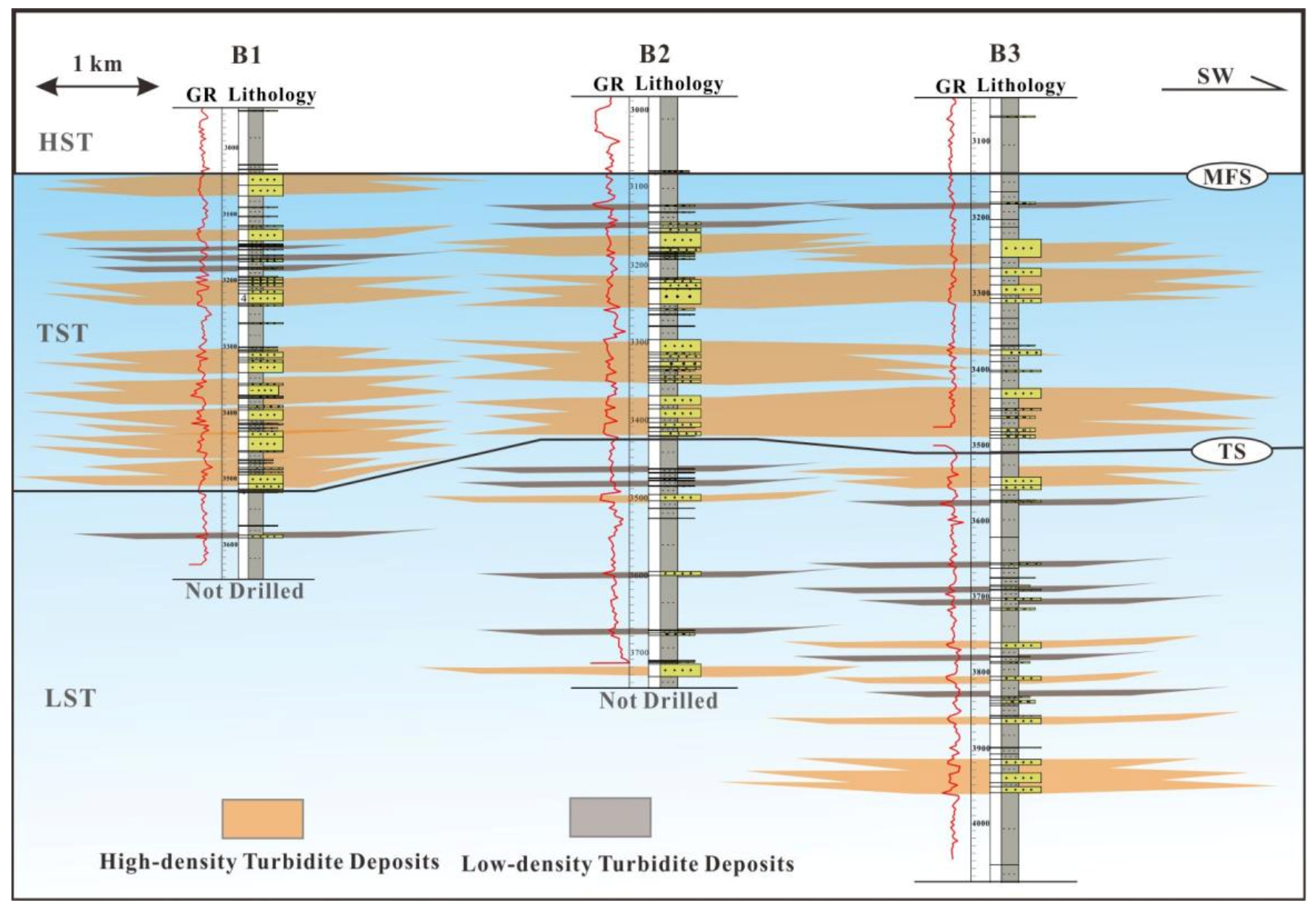
| A1 | A3 | |||||||||||||
|---|---|---|---|---|---|---|---|---|---|---|---|---|---|---|
| Number | BD/m | TCO/m | Number | BD/m | TCO/m | Number | BD/m | TCO/m | Number | BD/m | TCO/m | Number | BD/m | TCO/m |
| 1 | 3653.4 | 0.2349 | 40 | 2972.28 | 56.9968 | 1 | 4078.76 | 14.2683 | 40 | 3614.12 | 54.251 | 79 | 3154.76 | 106.5538 |
| 2 | 3637.08 | 5.7498 | 41 | 2957.16 | 53.3917 | 2 | 4054.04 | 21.0966 | 41 | 3607.4 | 51.3193 | 80 | 3149.88 | 102.9021 |
| 3 | 3615.48 | 13.6648 | 42 | 2944.68 | 51.2267 | 3 | 4036.6 | 23.6048 | 42 | 3600.04 | 62.6276 | 81 | 3143.24 | 104.2903 |
| 4 | 3591.48 | 16.5397 | 43 | 2930.76 | 50.5016 | 4 | 4023.8 | 31.9531 | 43 | 3578.44 | 66.2559 | 82 | 3131.4 | 98.8786 |
| 5 | 3572.52 | 10.0546 | 44 | 2915.4 | 51.9365 | 5 | 4005.16 | 44.0614 | 44 | 3564.36 | 79.0041 | 83 | 3126.52 | 92.5869 |
| 6 | 3563.16 | 17.9695 | 45 | 2897.88 | 47.1314 | 6 | 3982.76 | 40.2497 | 45 | 3541 | 76.3924 | 84 | 3122.52 | 85.8952 |
| 7 | 3539.4 | 19.6444 | 46 | 2886.84 | 46.8863 | 7 | 3976.04 | 43.7179 | 46 | 3533 | 73.1407 | 85 | 3118.76 | 79.5234 |
| 8 | 3521.88 | 25.3994 | 47 | 2871 | 46.4013 | 8 | 3961.96 | 37.7462 | 47 | 3525.96 | 73.249 | 86 | 3114.84 | 73.3117 |
| 9 | 3500.04 | 24.6743 | 48 | 2855.4 | 48.5562 | 9 | 3957.4 | 36.5745 | 48 | 3515.56 | 74.3172 | 87 | 3110.6 | 74.62 |
| 10 | 3484.92 | 32.8292 | 49 | 2837.16 | 44.7111 | 10 | 3947.88 | 40.2828 | 49 | 3504.04 | 75.7855 | 88 | 3098.92 | 70.2483 |
| 11 | 3460.92 | 31.3841 | 50 | 2824.92 | 38.946 | 11 | 3933.72 | 38.071 | 50 | 3492.28 | 75.8138 | 89 | 3093 | 71.9566 |
| 12 | 3446.28 | 32.099 | 51 | 2814.6 | 32.221 | 12 | 3925.4 | 34.0993 | 51 | 3481.96 | 76.7221 | 90 | 3080.92 | 70.4648 |
| 13 | 3429.72 | 33.534 | 52 | 2805.24 | 29.0959 | 13 | 3918.92 | 41.8876 | 52 | 3470.52 | 77.5503 | 91 | 3072.04 | 72.1731 |
| 14 | 3412.44 | 35.2089 | 53 | 2792.52 | 27.4108 | 14 | 3900.52 | 62.6359 | 53 | 3459.4 | 84.6986 | 92 | 3059.88 | 68.9214 |
| 15 | 3394.68 | 37.3638 | 54 | 2778.12 | 23.3257 | 15 | 3869.16 | 61.4641 | 54 | 3441.8 | 89.6069 | 93 | 3052.68 | 66.3097 |
| 16 | 3376.68 | 40.7187 | 55 | 2766.36 | 13.4806 | 16 | 3859.8 | 58.9324 | 55 | 3426.52 | 96.1952 | 94 | 3044.84 | 65.9379 |
| 17 | 3357.24 | 41.4337 | 56 | 2760.12 | 6.5156 | 17 | 3851.88 | 66.8807 | 56 | 3409.56 | 93.5834 | 95 | 3034.76 | 65.4062 |
| 18 | 3340.68 | 47.1886 | 57 | 2751 | 0.0305 | 18 | 3833.64 | 77.389 | 57 | 3401.88 | 100.5717 | 96 | 3025 | 63.4345 |
| 19 | 3319.08 | 43.1035 | 58 | 2741.64 | 0.2654 | 19 | 3812.68 | 73.9772 | 58 | 3384.52 | 99.32 | 97 | 3016.68 | 61.0628 |
| 20 | 3307.32 | 52.9384 | 59 | 2725.08 | −1.8997 | 20 | 3805.64 | 74.7255 | 59 | 3375.48 | 94.7883 | 98 | 3008.68 | 60.051 |
| 21 | 3281.64 | 51.1333 | 60 | 2711.16 | 0.2552 | 21 | 3794.44 | 87.3138 | 60 | 3369.72 | 108.2566 | 99 | 2999.32 | 58.0793 |
| 22 | 3267.2 | 58.4883 | 61 | 2692.68 | −1.4298 | 22 | 3771.56 | 86.6221 | 61 | 3345.8 | 128.8448 | 100 | 2990.68 | 56.1876 |
| 23 | 3243.8 | 70.6432 | 62 | 2678.28 | −2.3949 | 23 | 3761.8 | 83.5303 | 62 | 3314.84 | 126.4731 | 101 | 2982.12 | 53.3359 |
| 24 | 3215.48 | 72.6781 | 63 | 2663.16 | 0 | 24 | 3754.6 | 82.8386 | 63 | 3306.92 | 133.3014 | 102 | 2974.6 | 50.2441 |
| 25 | 3197.4 | 69.553 | 25 | 3745 | 83.2669 | 64 | 3289.72 | 137.0897 | 103 | 2967.4 | 44.6724 | |||
| 26 | 3184.68 | 65.4679 | 26 | 3734.12 | 82.2552 | 65 | 3275.48 | 134.2379 | 104 | 2962.68 | 41.1807 | |||
| 27 | 3172.92 | 67.6229 | 27 | 3724.76 | 76.9234 | 66 | 3267.96 | 136.1862 | 105 | 2955.72 | 39.209 | |||
| 28 | 3154.76 | 63.5378 | 28 | 3719.72 | 70.6317 | 67 | 3255.72 | 134.5345 | 106 | 2947.4 | 33.7972 | |||
| 29 | 3142.2 | 66.2927 | 29 | 3715.56 | 70.26 | 68 | 3247.08 | 148.0828 | 107 | 2942.52 | 31.1055 | |||
| 30 | 3123.48 | 66.7676 | 30 | 3705.64 | 67.6483 | 69 | 3222.92 | 145.471 | 108 | 2934.84 | 26.9738 | |||
| 31 | 3107.16 | 67.0025 | 31 | 3697.96 | 67.9166 | 70 | 3215 | 140.7793 | 109 | 2928.68 | 24.9221 | |||
| 32 | 3091 | 68.3575 | 32 | 3687.4 | 64.9048 | 71 | 3209.4 | 136.8876 | 110 | 2920.44 | 24.2303 | |||
| 33 | 3073.56 | 65.9524 | 33 | 3680.04 | 60.2131 | 72 | 3202.68 | 135.6359 | 111 | 2910.84 | 18.0186 | |||
| 34 | 3059.88 | 69.9873 | BD:Bottom depth TCO:Thickness cumulative offset | 34 | 3674.44 | 58.0014 | 73 | 3193.56 | 131.4241 | 112 | 2906.76 | 14.9269 | ||
| 35 | 3039.96 | 65.9022 | 35 | 3666.36 | 55.9497 | 74 | 3187.4 | 126.3324 | 113 | 2899.56 | 10.8752 | |||
| 36 | 3028.2 | 63.4971 | 36 | 3657.96 | 57.6579 | 75 | 3182.2 | 122.1207 | 114 | 2893.08 | 6.6634 | |||
| 37 | 3014.76 | 59.8921 | 37 | 3645.8 | 54.5662 | 76 | 3176.04 | 122.709 | 115 | 2887 | 5.1717 | |||
| 38 | 3002.52 | 58.687 | 38 | 3638.6 | 61.2345 | 77 | 3164.92 | 115.4572 | 116 | 2878.12 | 0 | |||
| 39 | 2987.64 | 57.9619 | 39 | 3621.48 | 57.8228 | 78 | 3161.8 | 112.0455 | ||||||
| Channelized Fan | Tongue-Shaped Fan | Lobe-Shaped Fan | |
|---|---|---|---|
| System Domain | HST | TST | TST |
| Region | A | B | C |
| Slope Break System | single fault | multiple faults | sedimentary slope break |
| Characteristics of log | Box-shaped | Box-shaped | funnel-shaped |
| Characteristics of seismic | Channel-shaped | Wedge-shaped | Sheet-shaped |
| Controlling factors | Steep slope, sand rich | Gentle slope, sand rich | Gentle slope, mud rich |
Disclaimer/Publisher’s Note: The statements, opinions and data contained in all publications are solely those of the individual author(s) and contributor(s) and not of MDPI and/or the editor(s). MDPI and/or the editor(s) disclaim responsibility for any injury to people or property resulting from any ideas, methods, instructions or products referred to in the content. |
© 2023 by the authors. Licensee MDPI, Basel, Switzerland. This article is an open access article distributed under the terms and conditions of the Creative Commons Attribution (CC BY) license (https://creativecommons.org/licenses/by/4.0/).
Share and Cite
Wang, H.; Jiang, S.; Zhang, Y.; Wang, X.; Liu, E.; Dong, X. Influence of Sublacustrine Fan Depositional Model on Distribution and Morphology of Reservoirs: A Case Study in Eastern Slope of Liaoxi Uplift, Bohai Bay Basin, East China. Energies 2023, 16, 851. https://doi.org/10.3390/en16020851
Wang H, Jiang S, Zhang Y, Wang X, Liu E, Dong X. Influence of Sublacustrine Fan Depositional Model on Distribution and Morphology of Reservoirs: A Case Study in Eastern Slope of Liaoxi Uplift, Bohai Bay Basin, East China. Energies. 2023; 16(2):851. https://doi.org/10.3390/en16020851
Chicago/Turabian StyleWang, Hao, Shu Jiang, Yuying Zhang, Xin Wang, Enhao Liu, and Xiaobin Dong. 2023. "Influence of Sublacustrine Fan Depositional Model on Distribution and Morphology of Reservoirs: A Case Study in Eastern Slope of Liaoxi Uplift, Bohai Bay Basin, East China" Energies 16, no. 2: 851. https://doi.org/10.3390/en16020851





